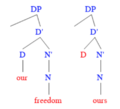Pronoun facts for kids
A pronoun is a word that takes the place of a noun. Think of it as a shortcut! Instead of repeating the same noun over and over, you can use a pronoun.
For example, imagine you're talking about your friend Tom:
- Tom has a new dog. Tom has named the dog Max and Tom lets the dog sleep by Tom's bed.
That sounds a bit clunky, right? Using pronouns makes it much smoother:
- Tom has a new dog. He has named it Max and he lets it sleep by his bed.
In this example, He, it, and his are all pronouns. They replace the nouns Tom and the dog. The noun that a pronoun replaces is called its antecedent. So, in the sentence "The dog that was walking down the street," the pronoun is that, and its antecedent is 'dog'.
Contents
How Pronouns Are Like and Unlike Nouns
Pronouns are a lot like nouns, but they also have some key differences.
Differences from Nouns
- No Articles: You usually don't put words like "the" or "a" in front of pronouns. For example, we don't say "the it."
- No Adjectives: Adjectives rarely describe pronouns. You wouldn't say "a tall he."
- Changing Forms: Many pronouns change their form depending on how they are used in a sentence. For example, you use "we" when it's the subject of a sentence, but "us" when it's the object.
Similarities to Nouns
- Number: Both nouns and pronouns can be singular (one) or plural (more than one). For example, "dog" (singular) and "dogs" (plural), or "I" (singular) and "we" (plural).
- Case: They both change based on their job in a sentence (like being the subject, object, or showing ownership).
- Gender: They can show if something is male, female, or neither.
- Sentence Roles: Nouns and pronouns can be used in almost the same places in sentences. They both name people, animals, places, or things.
Types of Pronouns You Use Every Day
There are several kinds of pronouns that help us speak and write clearly. Here are four main types: personal, reciprocal, interrogative, and relative.
| i | personal | you love them | Your sister loves herself |
| ii | reciprocal | we like each other | we are looking at one another |
| iii | interrogative | who is there? | what happened? |
| iv | relative | the person who saw it | the time which you told me |
Personal Pronouns in English
Personal pronouns are probably the ones you use the most! They refer to specific people or things. They change based on who is speaking (first person), who is being spoken to (second person), or who/what is being spoken about (third person).
| Singular (one) | Plural (more than one) | ||||||||
|---|---|---|---|---|---|---|---|---|---|
| Subject | Object | Possessive | Reflexive | Subject | Object | Possessive | Reflexive | ||
| First Person | I | me | my, mine | myself | we | us | our, ours | ourselves | |
| Second Person | you | you | your, yours | yourself | you | you | your, yours | yourselves | |
| Third Person | Feminine (female) | she | her | her, hers | herself | they | them | their, theirs | themselves |
| Masculine (male) | he | him | his | himself | |||||
| Neuter (thing/animal) | it | it | its | itself | |||||
- A subject pronoun is the one doing the action in a sentence. (Examples: I, You, He, She, It, We, They).
- An object pronoun is the one that receives the action. (Examples: me, him, us, them).
- A possessive pronoun shows who something belongs to. (Examples: my, yours, hers, theirs).
Another type of personal pronoun is called a reflexive pronoun. These words end in '-self' (for singular) or '-selves' (for plural), like myself, itself, or themselves. They are used when the subject and object of a verb are the same. For example: "She taught herself to play guitar."
The pronoun "it" and its forms ("its", "itself") are usually used for objects or animals, not people. However, "they" and its forms ("them", "their", "theirs") can be used for a single person when you don't know if they are male or female, or to be inclusive. For example: "The student will be told how much they will need to study."
Images for kids
See also
 In Spanish: Pronombre para niños
In Spanish: Pronombre para niños




